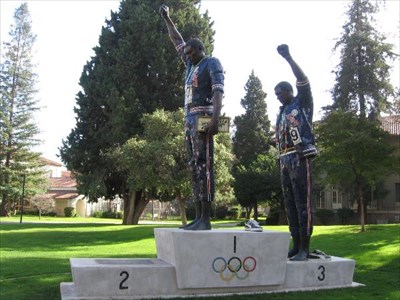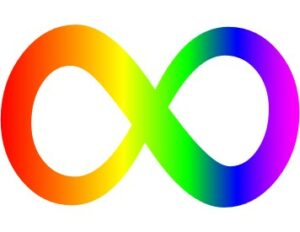1968 was a year of racial division and tragedy. African American’s had discussed the possibility of a boycott of the 1968 Summer Olympics. Dr. Martin Luther King Jr., a huge supporter of this boycott, said he would join Olympians John Carlos and Tommie Smith in Mexico to protest.1 These boycotts slowly fell through the cracks following the assassination of Martin Luther King Jr., and the riots during the Holy Week uprising. These riots were a direct response to the tragic death of MLK. Now that Dr. King would no longer be joining John Carlos in Mexico, other athletes became skeptical in boycotting the Summer Olympics. African American athletes began to change their stance on the boycott. The Olympians decided they would rather compete for themselves and their country, rather than sit out for a protest that would have a lot of attention in the media. But, John Carlos still felt like something needed to be done about the racially divided nation he lived in. With just a few weeks until the 1968 Summer Olympic Games, John Carlos had to decide how he would make his stand without the help or support of other Olympians or the civil rights activist Martin Luther King.2

With just ten days until the opening of the Summer Games, an unarmed group of student protesters gathered in Mexico City’s Three Cultures Square to plan their next step as a movement. The Mexican government sent bulldozers to break up the thousands of people who had gathered there. Mexican troops fired into the crowd, injuring and taking the lives of many people.3
This tragedy was eye-opening for both Carlos and Smith. Being in Mexico helped them to realize that they lived in a world that was unjust for all kinds of people. So the two decided that they needed to make a stand, and to be a voice for the voiceless.4 John Carlos and Tommie Smith knew that if they wanted to make a stand, it was imperative that they compete well enough to end up on the podium for the world to see.
Prior to their races, John Carlos and Tommie Smith decided that they both needed to make the podium together to make their stand through symbolism. The two men decided they would wear black gloves to symbolize strength and unity. They also wore beads around their necks to represent the history of lynching, and they decided to not wear shoes to symbolize black poverty in America.5 John Carlos and Tommie Smith wanted to do this because they felt that something needed to call attention to the broken and discriminated nature of their country. They wanted to make sure people were aware that there were those who lived in the “land of the free” that were far from free in terms of oppression.
The qualifying rounds had finally begun, and Tommie, unfortunately, pulled his groin in the quarter semi-finals. He refused to sit out though. Tommie was determined to compete because, to him, the race was so much bigger than he was, and bigger than anything else happening at the Olympics that summer.6
200m Final | Courtesy of Youtube
The finals had finally arrived. The next twenty seconds would be a defining moment for the two men. The gun sounded and the two flew. Tommie had a slow start but ended up setting a world record with a time of 19.57. John Carlos finished third, bested by Peter Norman by one step. But the two had made the podium, and it was time for them to make their stand. John Carlos told Norman what was about to happen, and Norman placed a button on him that read “We are Olympic Project for Human Rights,” to support the two men he was about to stand with on the podium.7

Carlos and Smith finally got their time on the podium, and as the two men’s fists shot up, 50,000 people fell silent. When the two walked toward the tunnel, following the National Anthem, people began booing and throwing things at them, screaming at them things like “Niggers need to go back to Africa,” and “I can’t believe this is how you Niggers treat us after we let you run in our games.”8 Then, in the midst of all this, the two stopped, threw their fists up again, screamed “right on,” and ran off the track.
The two got on the bus to begin the ride back to Olympic Village, and they got a glimpse of the rude awakening they were about to receive upon returning to the United States. As the two were about to sit down in the bus, a white man shouted: “those are the two that spit on my flag, you must be some kind of Communist.”9 The man continued badgering them until they arrived at Olympic Village.10
As the Olympics progressed, the USA Track team supported Carlos and Smith, and made signs to display throughout the remaining events. Following the United States winning the 4×100 relay finals, the team dedicated their win in an interview to Carlos and Smith. The US Olympic Committee was furious with the negative press that John Carlos and Tommie Smith were receiving for the scene they had caused, and the US Olympic Committee told the US team to either fly home or kick the two men off the team.11
Carlos and his wife were being bothered by the press constantly, and as they were heading to their hotel room one night, Carlos snapped and told the press: “Listen, I’m pretty pissed off with some of you white folk out there. The next one that takes a camera and microphone and sticks it up in my face, I am going to knock you down and act like you stole something.”12 These comments only escalated a situation that was already being blown up in the United States.13
After John Carlos and Tommie Smith returned home, they were suspended from the United States track team for making a scene on international television. And they began receiving death threats from many people.14 They were also being slammed in the media. Reporters called them “Blacked Skinned Storm Troopers,” while comparing their peaceful protest to a “Nazi Salute.”15 So much of the nation was infuriated with what these men had done. Some African Americans had even told them that they “set back black people 100 years.”16 The two refused to let the backlash quiet their message though, and they began speaking at colleges and in cities around the country to discuss equality in America. These men stood for something they believed in and got slandered in the media all over the world.17

Carlos and Smith felt like something needed to be done about the way people treated African Americans in America, and they refused to stand by and be complacent with the slow progress the United States had been making. It was not until 2008 that they received an ESPY award and were recognized in the media for their brave action.18 It’s truly tragic to see how these men were treated following the 1968 Summer Olympics, but it’s inspiring to see people fight and stand for what they believed in to call attention to issues they felt weren’t being adequately addressed in the United States. These men are part of the reason why we have made such great strides in the struggle for equality in America today.
- Erin Blakemore, “How the Black Power Protest at the 1968 Olympics Killed Careers,” History.com, February 22, 2018. Accessed February 14, 2019. https://www.history.com/news/1968-mexico-city-olympics-black-power-protest-backlash. ↵
- John Carlos, The John Carlos Story: The Sports Moment That Changed the World (Chicago, Illinois: Haymarket Books, 2011), 90-97. ↵
- Erin Blakemore, “How the Black Power Protest at the 1968 Olympics Killed Careers,” History.com, February 22, 2018. Accessed February 14, 2019. https://www.history.com/news/1968-mexico-city-olympics-black-power-protest-backlash. ↵
- Erin Blakemore, “How the Black Power Protest at the 1968 Olympics Killed Careers,” History.com, February 22, 2018. Accessed February 14, 2019. https://www.history.com/news/1968-mexico-city-olympics-black-power-protest-backlash. ↵
- John Carlos, The John Carlos Story: The Sports Moment That Changed the World (Chicago, Illinois: Haymarket Books, 2011), 110. ↵
- John Carlos, The John Carlos Story: The Sports Moment That Changed the World (Chicago, Illinois: Haymarket Books, 2011), 111-112. ↵
- John Carlos, The John Carlos Story: The Sports Moment That Changed the World (Chicago, Illinois: Haymarket Books, 2011), 112-113. ↵
- John Carlos, The John Carlos Story: The Sports Moment That Changed the World (Chicago, Illinois: Haymarket Books, 2011), 121. ↵
- John Carlos, The John Carlos Story: The Sports Moment That Changed the World (Chicago, Illinois: Haymarket Books, 2011), 123. ↵
- John Carlos, The John Carlos Story: The Sports Moment That Changed the World (Chicago, Illinois: Haymarket Books, 2011), 123. ↵
- Erin Blakemore, “How the Black Power Protest at the 1968 Olympics Killed Careers,” History.com, February 22, 2018. Accessed February 14, 2019. https://www.history.com/news/1968-mexico-city-olympics-black-power-protest-backlash. ↵
- John Carlos, The John Carlos Story: The Sports Moment That Changed the World (Chicago, Illinois: Haymarket Books, 2011), 124. ↵
- John Carlos, The John Carlos Story: The Sports Moment That Changed the World (Chicago, Illinois: Haymarket Books, 2011), 127. ↵
- John Carlos, The John Carlos Story: The Sports Moment That Changed the World (Chicago, Illinois: Haymarket Books, 2011), 130. ↵
- DeNeen L. Brown, “They didn’t #TakeTheKnee: The Black Power protest salute that shook the world in 1968,” The Washington Post, September 24, 2017. Accessed February 14, 2019. https://www.washingtonpost.com/news/retropolis/wp/2017/09/24/they-didnt-takeaknee-the-black-power-protest-salute-that-shook-the-world-in-1968/?utm_term=.97f6d2d0f51a. ↵
- “Sprinters are Both Suspended Because of Protest,” The Parsons Sun, Kansas, October 18, 1968. ↵
- DeNeen L. Brown, “They didn’t #TakeTheKnee: The Black Power protest salute that shook the world in 1968,” The Washington Post, September 24, 2017. Accessed February 14, 2019. https://www.washingtonpost.com/news/retropolis/wp/2017/09/24/they-didnt-takeaknee-the-black-power-protest-salute-that-shook-the-world-in-1968/?utm_term=.97f6d2d0f51a. ↵
- DeNeen L. Brown, “They didn’t #TakeTheKnee: The Black Power protest salute that shook the world in 1968,” The Washington Post, September 24, 2017. Accessed February 14, 2019. https://www.washingtonpost.com/news/retropolis/wp/2017/09/24/they-didnt-takeaknee-the-black-power-protest-salute-that-shook-the-world-in-1968/?utm_term=.97f6d2d0f51a. ↵



57 comments
Danielle Sanchez
This article was well written and contained great images to carry the story along. John Carlos felt like something needed to be done about the racial divided nation in which he lived. In 1968 the year the Summer Olympic games took place. John Carlos decided to make his stand without the help or support of other Olympians or the civil rights activist Martin Luther King.
Alexandra Ballard
This is such an incredible story. I really liked the way you incorporated multiple quotes, it really created a strong sense of the presence of the two men. I admire their strength and courage. It’s so upsetting to see that they peacefully went about things and were responded to with hate and disrespect. Naturally, they will get upset about the disrespect, and again that only makes things worse. What a vicious cycle. But I am glad they did finally receive the recognition they deserve!
Veronica Lopez
Impressive article! It was honestly and eye opener. I really enjoyed reading about the black power salute. I can’t believe John Carlos and Thomas Smith got suspended for “creating a scene” on national television. Although it’s understandable that this type of thing would happen during the late 1960s, it’s still leaves me surprised since all Americans should have freedom of speech and the freedom to do anything as important as the small protest.
Eliza Merrion
This article was very well written. I am always inspired by athletes and reading about how John Caros and Tommie used the Olympics as their platform to stand up for something bigger than themselves despite the injuries or hatred they received was truly inspirational. I also loved the video that you posted with this article, seeing the race that put them on the podium gave me goosebumps. I was also shocked to discover that they didn’t receive an award until 2008 which is extremely past due.
Reba Reyes
I was never informed about the racial divisions between people in the 1968 Olympics. It is sad that there was divisions of race between the countries. It is so fun to watch how athletic people are all around the world but to know that there was racism during these times makes me sad. I had never heard about John Carlos or Tommie Smith until being informed by this article. Such a great read!
Victor Rodriguez
Wow what an inspiring story! I definitely did not know about the racial division and tragedy during the 1968 Olympics. I was aware that this was a time when the United States was very divided and the Civil Rights Movement was still going on. However, an event like the Olympics is not meant to be divided. Instead, it is meant to be a time where countries come together and unify to celebrate athletes and their amazing hard work. All of the athletes that reach the Olympics work very hard and face obstacles to get there. It is terrible to hear about racist moments in such precious events. There should be no room for racial acts anywhere, or anytime. I am motivated to hear about the perseverance that these two men had to accomplish their goals and dreams. What a beautiful ending.
Jakob Trevino
Very powerful article Mr. Fraire, you have shown us two powerful men who defied all odds and after winning an Olympic medal rose for something more powerful than any game, and that is equality. Before reading this article, I have never heard of John Carlos and Tommie Smith. It is sad to say that even after all these years and fighting, there is still racism in our sports.
Eric Grant
First time hearing about John Carlos and Tommie Smith. What an inspiring story. What I admire the most is their commitment to their protest and their persistence towards doing what they believed to be right even when people (and even people of their own group) scorned them. Carlos and Tommie Smith were ahead of their time. This is extremely similar to Colin Kaepernick (at first sitting but later) kneeling during the national anthem.
Aleea Costilla
Ironically, I had seen pictures of this salute before but never knew its meaning. I was amazed to hear the struggle and repercussions John Carlos and Tommie Smith faced to bring awareness to racial division on the international stage. We can see similar parallels with celebrities that utilize their platform to advocate for topics in need of attention, especially during the Black Lives Matter movement. What I found astonishing is that Carlos and Smith did not receive recognition for their efforts until so much later.
Donte Joseph
I had never heard of this event until I read this article, but I think that the actions of John Carlos and Tommie Smith are very powerful. Their action reminds me of the current kneeling (which I am not comparing) because both actions have a deeper meaning and are faced with much back lash as well. I wish that athletes were taken more serious when they address political issues because they have a lot of influence that can be used to educate and inspire.